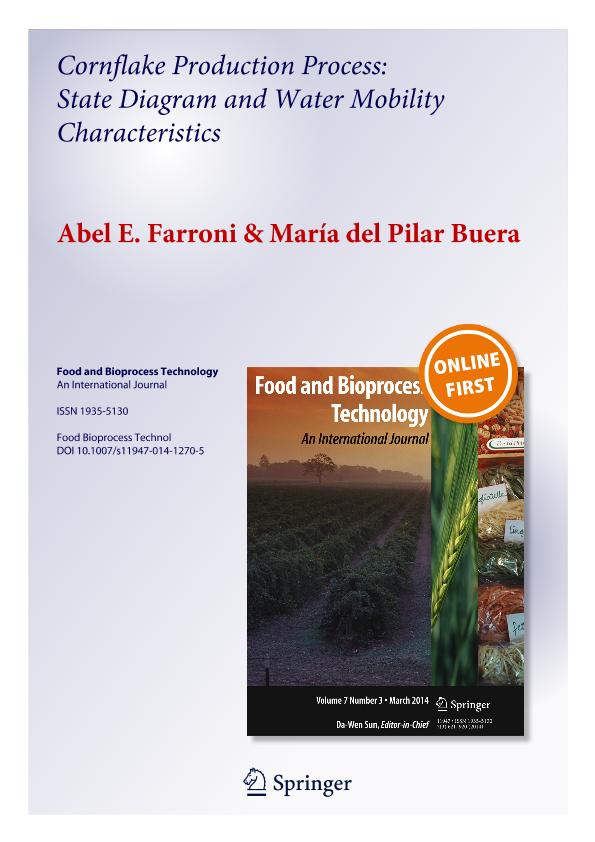Mostrar el registro sencillo del ítem
dc.contributor.author
Farroni, Abel Eduardo

dc.contributor.author
Buera, Maria del Pilar

dc.date.available
2018-01-12T17:39:31Z
dc.date.issued
2014-02
dc.identifier.citation
Buera, Maria del Pilar; Farroni, Abel Eduardo; Cornflake Production Process: State Diagram and Water Mobility Characteristics; Springer; Food and Bioprocess Technology; 7; 10; 2-2014; 2902-2911
dc.identifier.issn
1935-5130
dc.identifier.uri
http://hdl.handle.net/11336/33081
dc.description.abstract
The aim of this work was to fully understand the physicochemical events involved in the development of the cornflake structure, taking into consideration the water sorption characteristics and state changes in the solid phase as a function of temperature and water content. Complementarily, time-resolved proton nuclear magnetic resonance (1H-TD-NMR) was used to evaluate the dynamic aspects at different stages of the classical cornflake production process. Processing had the effect of reducing the water sorption capacity of the samples and of increasing the sorption energy. While the minimal water content necessary to detect starch gelatinization was lower than the water content at which frozen water was detected by DSC (W = 24%), water excess for an adequate cooking needs to be higher than this value. By describing the process using supplemented state diagrams, it was possible to delimitate regions in which the main components (starch and proteins) underwent specific changes such as gelatinization or crosslinking. The data of comparative mobility of water populations helped to understand the occurrence of those changes. The physical state of the samples could be established for each process stage, the matrix was soft and malleable when important internal and external forces were applied which allowed the change of shape, microstructure, and appearance of the product. Physical hardening occurred after toasting to create the typical expected crispy texture. The data of comparative mobility of proton populations helped to understand the occurrence of those changes, the conditions prevailing in each stage, and the physical state of the sample.
dc.format
application/pdf
dc.language.iso
eng
dc.publisher
Springer

dc.rights
info:eu-repo/semantics/openAccess
dc.rights.uri
https://creativecommons.org/licenses/by-nc-sa/2.5/ar/
dc.subject
State Diagrams
dc.subject
Water Sorption Isotherm
dc.subject
Molecular Mobility
dc.subject
Flaking
dc.subject.classification
Otras Ciencias Químicas

dc.subject.classification
Ciencias Químicas

dc.subject.classification
CIENCIAS NATURALES Y EXACTAS

dc.title
Cornflake Production Process: State Diagram and Water Mobility Characteristics
dc.type
info:eu-repo/semantics/article
dc.type
info:ar-repo/semantics/artículo
dc.type
info:eu-repo/semantics/publishedVersion
dc.date.updated
2018-01-11T19:36:20Z
dc.identifier.eissn
1935-5149
dc.journal.volume
7
dc.journal.number
10
dc.journal.pagination
2902-2911
dc.journal.pais
Estados Unidos

dc.journal.ciudad
Nueva York
dc.description.fil
Fil: Farroni, Abel Eduardo. Instituto Nacional de Tecnología Agropecuaria. Centro Regional Buenos Aires Norte. Estación Experimental Agropecuaria Pergamino; Argentina. Consejo Nacional de Investigaciones Científicas y Técnicas; Argentina
dc.description.fil
Fil: Buera, Maria del Pilar. Universidad de Buenos Aires. Facultad de Ciencias Exactas y Naturales. Departamento de Industrias; Argentina. Consejo Nacional de Investigaciones Científicas y Técnicas; Argentina
dc.journal.title
Food and Bioprocess Technology

dc.relation.alternativeid
info:eu-repo/semantics/altIdentifier/doi/http://dx.doi.org/10.1007/s11947-014-1270-5
dc.relation.alternativeid
info:eu-repo/semantics/altIdentifier/url/https://link.springer.com/article/10.1007%2Fs11947-014-1270-5
Archivos asociados
